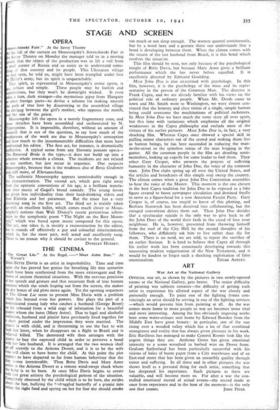ART
War Art at the National Gallery OFFiciAL war art, as shown by the pictures in two newly-opened rooms at the National Gallery, gets better. The major difficulty of painting war subjects remains—the difficulty of getting each artist to experience his allotted aspect of the war closely and personally enough. To paint one of the fighting fronts con- vincingly an artist should be serving in one of the fighting services —which would prevent him from painting at all. As the war comes more home to more people so war art becomes 'more vital and more interesting. Among the less obviously imposing works here some water-colours sent home by Edward Bawden from the Middle East have great beauty : in particular, one of the sun rising over a wooded valley which has a lot of that combined strangeness and reality that has always given pleasure in his work. Eric Ravilious has managed to make Control Rooms look like the urgent things they are. Anthony Gross has given emotional intensity to a scene wreathed in barbed wire on Dover front. Graham Sutherland has been particularly successful with his visions of bales of burnt paper from a City warehouse and of an East-end street that has been given an unearthly quality through terror and suffering. In all these and in other pictures the war shows itself as a personal thing for each artist, something that has deepened his experience. Such pictures as these are valuable, and will become more so. For after a war the con- trolled emotional record of actual events—the record made at once from experience and in the heat of the moment—is the only


























 Previous page
Previous page